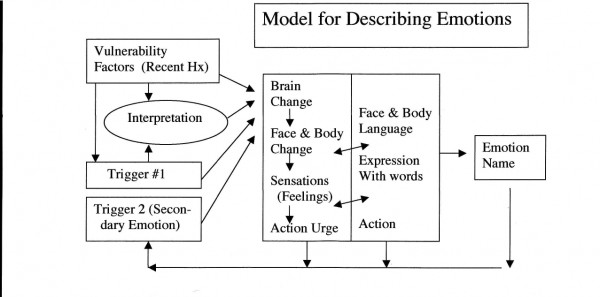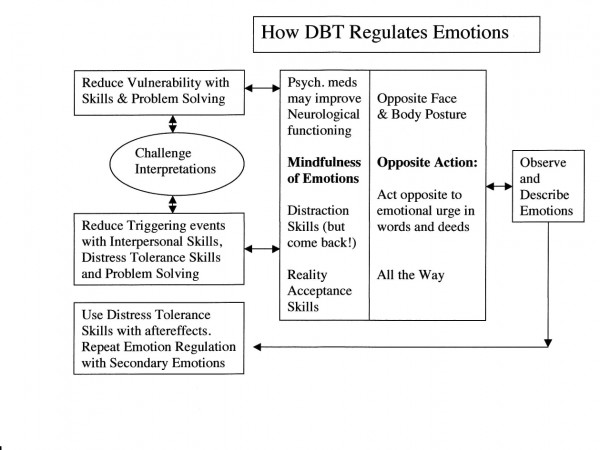Emotional Regulation
New! See my two-part video on Emotion Regulation and DBT Skills: click on the links for part 1 and part 2.
Emotional Regulation
One might think that people whose emotions get them into trouble would know a lot about those emotions. Actually, the opposite is true, for good historical reasons. In order to try to “stop being so emotional” and fit in with less emotionally sensitive people, clients who meet criteria for BPD have often learned to ignore their feelings, and really don’t know how they are feeling until they are completely taken over by an emotion.
Often, people with borderline behaviors are emotion phobic; they have been trained with an environment invalidating of feeling to suppress awareness of the low and mid-range intensities of emotion. Unfortunately, this serves to make emotional extremes more necessary and frequent. What’s worse is that these people have not been supported to learn how emotions work, and to know about the points within an emotional experience at which the intensity and quality of the experience can be regulated. DBT addresses these deficits by teaching clients how to find these “choice points” and take actions to regulate their emotional experience.
A significant portion of the Emotion Regulation module is spent teaching clients how to track the sensory details and components of their emotions. A diagram of how emotions work is presented, and descriptive words for the different components are given for several basic emotions. Here is a simplified version of the diagram:
 To explain the diagram, we begin on the left side: a typical emotional experience begins with something happening in the external world, that “triggers” the emotional response. However, as the arrow coming up from the lower box indicates, one emotion can trigger a “secondary emotion”, as when feeling fear triggers anger, anger triggers shame, or love triggers joy. Once a triggering event occurs, there is usually an interpretation made by the thinking mind about the meaning of the trigger. The sensations that occur in the body and the urges to take action are typically felt to constitute the experience of the emotion, and take place mainly in response to the interpretation.
To explain the diagram, we begin on the left side: a typical emotional experience begins with something happening in the external world, that “triggers” the emotional response. However, as the arrow coming up from the lower box indicates, one emotion can trigger a “secondary emotion”, as when feeling fear triggers anger, anger triggers shame, or love triggers joy. Once a triggering event occurs, there is usually an interpretation made by the thinking mind about the meaning of the trigger. The sensations that occur in the body and the urges to take action are typically felt to constitute the experience of the emotion, and take place mainly in response to the interpretation.
Vulnerability factors (such as being tired, hungry, pre-menstrual, or physically sick) will strongly affect the emotional experience, however, as well as the interpretation and even the trigger. Emotions are communicated in facial and postural expressions, actions, and words (including those used to describe the emotion). These expressions usually intensify the emotional experience. However, as will be seen below, it is possible to consciously override these expressions in such a way as to change the emotional experience.
Everything on the left side of the diagram — including vulnerability factors, triggers, interpretations, facial and postural expression, actions and words –- can be influenced by clients as they learn DBT skills. Changing these components will inevitably and dramatically change the emotional experience.
 The second half of the Emotion Regulation module is spent teaching the skills needed for changing these components:
The second half of the Emotion Regulation module is spent teaching the skills needed for changing these components:
Emotional vulnerability factors are decreased by getting physical exercise, avoiding non-prescription drugs and alcohol, treating physical illness, getting the right amount of sleep, proper eating, mindfulness practice, etc.
Negative emotional triggers are reduced by improved relationship and distress tolerance skills, and by solving life problems, while positive triggers are increased by planning daily pleasant events, working toward personal goals, repairing and improving relationships, and switching the focus of awareness towards the positive experiences in life.
Interpretations are modified by teaching clients to challenge negative beliefs that create suffering and prevent positive change.
Facial and postural expressions, words and actions can be consciously reversed from what is habitually urged by an emotion, and as this occurs the emotional experience is changed. For example, insofar as the emotion of “fear” urges us to run away, the principle of Opposite Action teaches us to face what we fear over and over until we become confident in our ability to deal with it. “Depression” urges hiding away and giving up, so the Opposite Action is to push ourselves to engage in activities until we feel better. Anger urges confrontation, or even violence, and so Opposite Action prescribes taking a time out, moving away from the person we’re mad at, until we calm down.
Even the tendency to run away from emotions is reversed in DBT as clients are taught to mindfully observe and experience the waves of emotions that arise and disappear within them. This “Mindfulness of Emotion” skill is the acceptance mode counterpart of “Changing Emotions by Opposite Action”. Meeting emotions simply and directly, without trying to repress or exaggerate them, allows the body to go through its physiological process for dealing with them and return to a resting baseline in the most efficient manner. That this can happen, however, is new information to someone who has not been supported to experience emotion and get through it, and this skill takes some time and a lot of support to acquire.
All of these skills, indeed, must practiced repeatedly and “overlearned”, in order to be available to us in an emotional crisis. For this reason, it is extremely valuable to be in the supportive environment of a DBT skills group or individual skills training.
